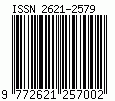Strategic Integration of Creative and Blue Economies through Digital Media: A Case Study of PT Digipedia Karya Pratama in Indonesia’s Maritime Region
DOI:
https://doi.org/10.12928/channel.v13i1.1062Keywords:
Creative industry, Blue economy, Sustainability, Digital media, Strategic communicationAbstract
This study explores the strategic integration of creative industry practices and blue economy principles through the lens of a small digital media enterprise in Indonesia’s Riau Islands. Using a qualitative case study approach, it investigates how PT Digipedia Karya Pratama navigates structural constraints—such as limited human capital, financing, and innovation capacity—to engage in sustainable digital innovation. Data were collected through semi-structured interviews, document analysis, and direct observation, and analyzed thematically alongside a SWOT framework. Findings reveal that while the company’s strengths lie in institutional networks and cultural embeddedness, it struggles with underdeveloped game development initiatives and insufficient engagement in regional innovation ecosystems. However, its strategic location and narrative capital offer pathways for leveraging marine sustainability themes through serious games and digital storytelling. The study contributes to the literature by highlighting the role of peripheral creative firms in aligning digital transformation with blue economy goals, proposing a replicable model for innovation-driven development in coastal regions. Practical recommendations are offered to strengthen talent development, multi-stakeholder collaboration, and culturally grounded game production. This case contributes to the discourse on inclusive innovation, sustainability communication, and creative economy policy in emerging economies.
References
Anggraeni, L. D. (2023). Promotion and branding in the local digital game industry. Journal of Visual Design and Communication, 6(2), 55–66.
Arjana, I. G. B. (2017). Geography of tourism and the creative economy. PT. RajaGrafindo Persada-Rajawali Press.
Badan Ekonomi Kreatif Indonesia. (2019). Creative economy development index of Indonesia. Bekraf.
Bappenas. (2023). Indonesia’s blue economy development plan. https://bappenas.go.id
Caves, R. E. (2000). Creative industries: Contracts between art and commerce. Harvard University Press.
Digipedia Karya Pratama. (2023). Company profile.
Etzkowitz, H., & Leydesdorff, L. (1997). Introduction to special issue on science policy dimensions of the Triple Helix of university-industry-government relations. Science and Public Policy, 24(1), 2–5. https://doi.org/10.1093/spp/24.1.2
Fatimah, F. N. D. (2016). SWOT analysis techniques: Guidelines for developing effective & efficient strategies and how to manage forces & threats. Quadrant.
Florida, R. (2003). Cities and the creative class. City & Community, 2(1), 3–19. https://doi.org/10.1111/1540-6040.00034
Haris, M. A., & Rahman, T. (2024). The role of educational games in increasing maritime environmental awareness. Journal of Education and Game Technology, 2(1), 40–52.
Hasrullah. (2024). The potential of creative industries in diversifying the blue economy in the Riau Islands: An exploratory analysis. Journal of Archipelago, 3(1), 83–98. https://doi.org/10.69853/ja.v3i01.111
Hollweck, T. (2015). Robert K. Yin. (2014). Case study research design and methods. Canadian Journal of Program Evaluation, 30(1), 108–110. https://doi.org/10.3138/cjpe.30.1.108
Howkins, J. (2001). The creative economy: How people make money from ideas. Penguin.
Jenkins, H., Purushotma, R., Weigel, M., Clinton, K., & Robison, A. (2009). Confronting the challenges of participatory culture: Media education for the 21st century. MIT Press. https://doi.org/10.7551/mitpress/8435.001.0001
Kementerian Komunikasi dan Informatika. (2024). Indonesia digital transformation roadmap 2024–2030. https://kominfo.go.id
McRobbie, A. (2016). Be creative: Making a living in the new culture industries. Polity Press.
Ministry of Tourism and Creative Economy. (2023). Tourism & creative economy outlook 2023/2024. Ministry of Tourism and Creative Economy of the Republic of Indonesia. https://tasransel.kemenparekraf.go.id/outlook-pariwisata-dan-ekonomi-kreatif-2023-2024/show
Muhammad, N. (2024, January 11). Indonesia is the top contributor to games on the Steam platform in Southeast Asia. Data Said. https://databoks.katadata.co.id/datapublish/2024/01/11/indonesia-jadi-kontributor-terbesar-game-on-platform-steam-di-asia-tenggara
Nugroho, D., & Santosa, S. (2023). Human resource capacity in the development of digital-based creative industries. Journal of Creative Human Resources, 4(1), 15–28.
Nurhaliza, D. (2023). Digitizing the maritime sector through educational games: A case study on marine ecosystem-based game development. Maritime Informatics Media, 2(1), 23–35.
OECD. (2019). The future of tourism and the creative economy. https://www.oecd.org
Panjaitan, T. D., & Hutauruk, R. H. (2021). Creative economy development in the Batam autonomous region. Journal of Law and Policy Transformation, 6(2), 85–92. https://doi.org/10.37253/jlpt.v6i2.6317
Pratt, A. C. (2008). Creative cities: The cultural industries and the creative class. Geografiska Annaler: Series B, Human Geography, 90(2), 107–117. https://doi.org/10.1111/j.1468-0467.2008.00281.x
Purnama, F. (2024, October 14). Indonesia's game industry revenue reaches IDR 25 trillion. Antara - Indonesian News Agency. https://www.antaranews.com/berita/3774033/pendapatan-industri-game-indonesia-capai-rp25-triliun
Putri, A. M., & Nugroho, R. A. (2023). Utilization of maritime potential in the creative industry: A blue economy perspective. Journal of Creativity, 7(3), 67–79.
Scott, A. J. (2014). Beyond the creative city: Cognitive–cultural capitalism and the new urbanism. Regional Studies, 48(4), 565–578. https://doi.org/10.1080/00343404.2014.891010
Statista. (2024). Market insight: Game Indonesia. https://www.statista.com/outlook/amo/app/games/indonesia
Sugiharto, T., & Hidayat, R. (2022). Competitive advantage analysis in Indonesia's creative industry. Journal of Creative Management and Business, 3(1), 18–32.
Sulistyo-Basuki, L. (2006). Political reformation and its impact on library and information science education and practice: A case study of Indonesia during and after the Soeharto administration.
Throsby, D. (2008). Creative industries and cultural policy. International Journal of Cultural Policy, 14(1), 15–29. https://doi.org/10.1080/10286630701856437
Tidd, J. (2006). A review of innovation models. Imperial College London, 16, 0–17.
UNCTAD. (2021). Creative economy outlook: Trends in international trade in creative industries 2002–2020. United Nations. https://unctad.org/webflyer/creative-economy-outlook-2022
Wahyudi, R. (2022). Innovation strategies in developing a blue economy based on local wisdom. Journal of Maritime Economics, 4(1), 44–59.
We Are Social. (2024). Digital 2024: Global overview report (p. 162). https://wearesocial.com/id/blog/2024/01/digital-2024/
World Bank. (2021). Blue economy development framework. https://www.worldbank.org/en/topic/oceans
Wuryaningrat, N. F. (2020, December). Innovation capabilities in Indonesia’s creative industries. Aswaja Youth Forum.
Downloads
Published
How to Cite
Issue
Section
License
Copyright (c) 2025 CHANNEL: Jurnal Komunikasi

This work is licensed under a Creative Commons Attribution-ShareAlike 4.0 International License.






